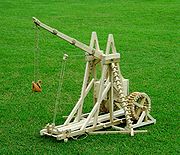
Warwolf
Encyclopedia


Trebuchet
A trebuchet is a siege engine that was employed in the Middle Ages. It is sometimes called a "counterweight trebuchet" or "counterpoise trebuchet" in order to distinguish it from an earlier weapon that has come to be called the "traction trebuchet", the original version with pulling men instead of...
ever made. It was created in Scotland
Scotland
Scotland is a country that is part of the United Kingdom. Occupying the northern third of the island of Great Britain, it shares a border with England to the south and is bounded by the North Sea to the east, the Atlantic Ocean to the north and west, and the North Channel and Irish Sea to the...
by order of King
King
- Centers of population :* King, Ontario, CanadaIn USA:* King, Indiana* King, North Carolina* King, Lincoln County, Wisconsin* King, Waupaca County, Wisconsin* King County, Washington- Moving-image works :Television:...
Edward Longshanks
Edward I of England
Edward I , also known as Edward Longshanks and the Hammer of the Scots, was King of England from 1272 to 1307. The first son of Henry III, Edward was involved early in the political intrigues of his father's reign, which included an outright rebellion by the English barons...
of England
England
England is a country that is part of the United Kingdom. It shares land borders with Scotland to the north and Wales to the west; the Irish Sea is to the north west, the Celtic Sea to the south west, with the North Sea to the east and the English Channel to the south separating it from continental...
, during the siege of Stirling Castle
Stirling Castle
Stirling Castle, located in Stirling, is one of the largest and most important castles, both historically and architecturally, in Scotland. The castle sits atop Castle Hill, an intrusive crag, which forms part of the Stirling Sill geological formation. It is surrounded on three sides by steep...
, as part of the Scottish Wars of Independence
Wars of Scottish Independence
The Wars of Scottish Independence were a series of military campaigns fought between the independent Kingdom of Scotland and the Kingdom of England in the late 13th and early 14th centuries....
.
When disassembled, the weapon would fill 30 wagons. It took five master carpenters and forty-nine other labourers at least three months to complete.
A contemporary account of the siege states, "During this business the king had carpenters construct a fearful engine called the lup-de-guerre (sic., War wolf), and this when it threw, brought down the whole wall."
Even before construction could be completed, the sight of the giant engine so intimidated the Scots that they tried to surrender. Edward sent the truce party back inside the castle, declaring, "You don't deserve any grace, but must surrender to my will." Edward decided to carry on with the siege and witness for himself the power of the masterful weapon. The Warwolf accurately hurled missiles weighing as much as three hundred pounds and levelled a large section of the curtain wall.
Postscript
The recapture of Stirling Castle by the Scots was the immediate cause of the Battle of Bannockburn in 1314, when Edward Longshanks's son Edward II of England came with an army two or three times the Scottish numbers, and lost.In the original records
Some of the original parchment rolls of the accounts of King Edward survive. Two references to the War Wolf, in Latin read;Domino Alexandro le Convers, pro denariis per ipsum datis,..., carpentariis facientibus ingenium quod vocatur Lupus Guerre', et aliis operaris diversis operantibus, ... mensibus Maii et Junii anno presenti (1304), viio die Junii, .... 10 s.The first means; 'To Master Alexander le Convers, for money paid by him to the carpenters making the engine called 'War Wolf', and other workers working (also on the engine), in May and June 1304, 10 shillings on 7 June 1304.
Thome de Viridi Campo, valleto regine, de dono regis in recompensacionem laboris quem sustenit circa facturem Lupus Guerre quem rex fieri ordinavit pro insultu castri de Stryvelyn, ..... xl Li.
The following record reads; to Thomas de Viridus Campus, the queen's valet, recompensed at the King's hand for his labours in the making of the 'War Wolf', which the King ordered to be made to slight
Slighting
A slighting is the deliberate destruction, partial or complete, of a fortification without opposition. During the English Civil War this was to render it unusable as a fort.-Middle Ages:...
Stirling Castle, £40.
Reginald the Janitor was paid wages for guarding its beams for forty nights in June and July 1304.
External links
- Secrets of Lost Empires: Medieval Siege (building of and history of trebuchets), from the NOVANOVA (TV series)Nova is a popular science television series from the U.S. produced by WGBH Boston. It can be seen on the Public Broadcasting Service in the United States, and in more than 100 other countries...
website - An article on Trebuchet Mechanics (in PDF formatPortable Document FormatPortable Document Format is an open standard for document exchange. This file format, created by Adobe Systems in 1993, is used for representing documents in a manner independent of application software, hardware, and operating systems....
)

